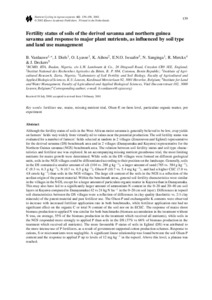| dc.contributor.author | Vanlauwe, Bernard |
| dc.contributor.author | Diels, J. |
| dc.contributor.author | Lyasse, O. |
| dc.contributor.author | Aihou, K. |
| dc.contributor.author | Iwuafor, E. |
| dc.contributor.author | Sanginga, N. |
| dc.contributor.author | Merckx, R. |
| dc.contributor.author | Deckers, J. |
| dc.date.accessioned | 2019-12-04T11:21:24Z |
| dc.date.available | 2019-12-04T11:21:24Z |
| dc.date.issued | 2002 |
| dc.identifier.citation | Vanlauwe, B., Diels, J., Lyasse, O., Aihou, K., Iwuafor, E., Sanginga, N., ... & Deckers, J. (2002). Fertility status of soils of the derived savanna and northern guinea savanna and response to major plant nutrients, as influenced by soil type and land use management. Nutrient Cycling in Agroecosystems, 62(2), 139-150. |
| dc.identifier.issn | 1385-1314 |
| dc.identifier.uri | https://hdl.handle.net/20.500.12478/3773 |
| dc.description.abstract | Although the fertility status of soils in the West African moist savanna is generally believed to be low, crop yields on farmers' fields vary widely from virtually nil to values near the potential production. The soil fertility status was evaluated for a number of farmers' fields selected at random in 2 villages (Zouzouvou and Eglimé) representative for the derived savanna (DS) benchmark area and in 2 villages (Danayamaka and Kayawa) representative for the Northern Guinea savanna (NGS) benchmark area. The relation between soil fertility status and soil type characteristics and fertilizer use was explored. In an accompanying missing nutrient greenhouse trial, the most limiting nutrients for maize growth were determined. While soils in the DS villages were formed on different geological units, soils in the NGS villages could be differentiated according to their position on the landscape. Generally, soils in the DS contained a smaller amount of silt (104 vs. 288 g kg−1), a larger amount of sand (785 vs. 584 g kg−1), C (9.3 vs. 6.3 g kg−1), N (0.7 vs. 0.5 g kg−1), Olsen-P (10.7 vs. 5.4 mg kg−1), and had a higher CEC (7.0 vs. 4.8 cmolc kg−1) than soils in the NGS villages. The large silt content of the soils in the NGS is a reflection of the aeolian origin of the parent material. Within the benchmark areas, general soil fertility characteristics were similar in the villages in the NGS, except for a larger amount of particulate organic matter in Kayawa than in Danayamaka. This may also have led to a significantly larger amount of ammonium-N content in the 0–20 and 20–40 cm soil layers in Kayawa compared to Danayamaka (42 vs 24 kg N ha−1 in the 0–20 cm soil layer). Differences in topsoil soil characteristics between the DS villages were a reflection of differences in clay quality (kaolinitic vs. 2:1 clay minerals) of the parent material and past fertilizer use. The Olsen-P and exchangeable K contents were observed to increase with increased fertilizer application rate in both benchmarks, while fertilizer application rate had no significant effect on the organic C or total N content of the soil nor on its ECEC. The response of maize shoot biomass production to applied N was similar for both benchmarks (biomass accumulation in the treatment without N was, on average, 55% of the biomass production in the treatment which received all nutrients), while soils in the NGS responded more strongly to applied P than soils in the DS (37% vs 66% of biomass production in the treatment which received all nutrients). The more favourable P status of soils in Eglimé (DS) was attributed to the more intense use of P fertilizers, as a result of government-supported cotton production schemes. Response to cations, S or micronutrients were neglegible. A significant linear relationship was found between the soil Olsen-P content and the response to applied P up to levels of 12 mg kg−1 in the topsoil. Above this level, a plateau was reached. |
| dc.description.sponsorship | Directorate-General for Development Cooperation and Humanitarian Aid, Belgium |
| dc.language.iso | en |
| dc.subject | Fertilizer Use |
| dc.subject | Maize |
| dc.subject | Missing Nutrient Trial |
| dc.subject | Olsen-P |
| dc.subject | On-Farm Level |
| dc.subject | Particulate Organic Matter |
| dc.subject | Pot Experiment |
| dc.title | Fertility status of soils of the derived savanna and northern guinea savanna benchmarks and response to major plant nutrients, as influenced by soil type and land use management |
| dc.type | Journal Article |
| dc.description.version | Peer Review |
| cg.contributor.affiliation | International Institute of Tropical Agriculture |
| cg.contributor.affiliation | Institut National des Recherches Agricoles du Bénin |
| cg.contributor.affiliation | Institute of Agricultural Research, Nigeria |
| cg.contributor.affiliation | Katholieke Universiteit Leuven |
| cg.coverage.region | Africa |
| cg.coverage.region | West Africa |
| cg.coverage.country | Nigeria |
| cg.isijournal | ISI Journal |
| cg.authorship.types | CGIAR and developing country institute |
| cg.iitasubject | Maize |
| cg.iitasubject | Soil Information |
| cg.iitasubject | Nutrition |
| cg.accessibilitystatus | Limited Access |
| local.dspaceid | 95928 |
| cg.identifier.doi | https://doi.org/10.1023/A:1015531123854 |

